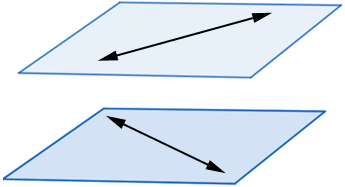
It could also apply to a line and a plane and two planes. And because there's only 3 pairs I decided to write them all up, so don't just think that parallelism applies only to two coplanar lines. And we can say that two planes can be parallel if they never intersect. We said that we could have a line parallel to a plane again there's many and I just chose one. So two coplanar lines if we look at our cube, there's lots of them but I only named one pair and that was a, b, and c, d. So we have a, b, f, e is parallel to this bottom face which is c, d, h, g. a, e, h, d is parallel to this other side face b, f, g, c and last we could say our two bottom faces or the top and the bottom face. So I'm going to say a, b, c, d is parallel to the face that is opposite to it e, f, g, h, so I'm going to say e, f, g, h but we could also consider the other 2 pairs, so we could say this side face a, e, h, d. So we can say that line segment a, b is parallel to plane c, d, h, g so that line will never intersect that plane they're considered parallel.Īnd last what about two planes? Well since we have a cube we have 3 pairs of parallel planes, so we could start off with front plane a, b, c, d. Which means it could be parallel to this bottom face, so the bottom face is c, d, h and g. Now what about a line and a plane? How can those be parallel? Well taking that same plane a, b, c, d if I took one edge let's say a, b so I'm going to say line segment a, b line segment a, b intersects this plane a, b, c, d it also intersects this plane a, b, e, f. So those will be 2 that are in the same plane that will never intersect. I could say that this segment a, b so I'm going to write segment a, b is parallel to segment c, d. So if we start off by saying well two coplanar lines, if I look at this front face, so that's going to be one plane. So this cube we'll assume that we have 6 congruent faces and that opposite faces are parallel. So let's start off by identifying two coplanar lines in this cube right here. But a line and plane can be parallel to each other and two planes can be parallel to each other. We could be talking about well, the obvious the two coplanar lines that's what we're going to see the most. In physics this may be interpreted as the path that a particle follows if no force is applied to it.In Geometry when we talk about this concept of two things being parallel, we aren't just talking about two parallel lines. A geodesic is the shortest path between two points in a given geometry. In non-Euclidean geometry, it is more common to talk about geodesics than (straight) lines.
 What i tried doing was taking the directional vector of both lines <5 5 -4> <1 8 -3>, and crossing.
What i tried doing was taking the directional vector of both lines <5 5 -4> <1 8 -3>, and crossing. This never holds for skew lines.Ī line m and a plane q in three-dimensional space, the line not lying in that plane, are parallel if and only if they do not intersect.Įquivalently, they are parallel if and only if the distance from a point P on line m to the nearest point in plane q is independent of the location of P on line m. Showing skew lines lie in parallel planes. Planes that do meet are called intersecting planes.
PARALLEL PLANES FREE
A journey between genres, and essay of free thinking and an intimate look at how 12. Two distinct lines l and m in three-dimensional space are parallel if and only if the distance from a point P on line m to the nearest point on line l is independent of the location of P on line m. Go back to the definition of parallel planes: they share the same space and will never meet. Parallel Planes is a documentary film portraying 12 American musicians. Only if they are in a common plane are they called parallel otherwise they are called skew lines. Two lines in the same three-dimensional space that do not intersect need not be parallel. The parallel symbol is ∥ Two lines in three-dimensional space

2.2 Two lines in three-dimensional space.2.1.4 Distance between two parallel lines.


 0 kommentar(er)
0 kommentar(er)
